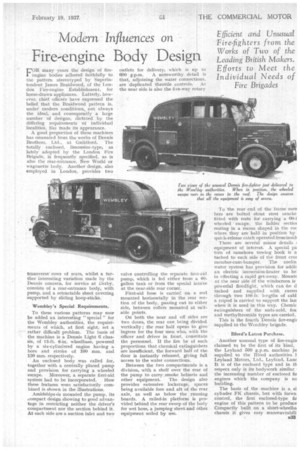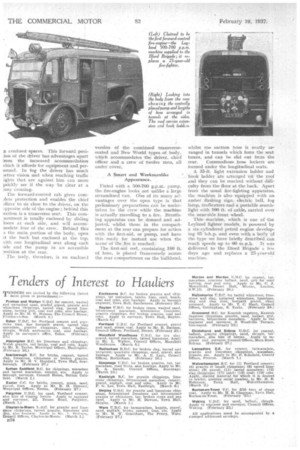Modern Influences on
Page 51

Page 52

If you've noticed an error in this article please click here to report it so we can fix it.
Fire-engine Body Design
OR many years the design of fire": engine bodies adheredfaithfUlly to the pattern stereotyped by Superintendent James Braidwood, of the Louden Fire-engine Establishment, for horse-drawn appliances. Latterly, however, chief officers have expressed the belief that the Braidwood pattern is, under modern conditions,. not always the ideal, and consequently a large number of designs, dictated by the differing requirements of individual localities, has made its appearance.
A good proportion of these machines has emanated from the works of Dennis Brothers, Ltd., at Guildford. The totally enclosed, limousine-type, as lately adopted by the London Fire Brigade, is frequently specified, as is also the rear-entrance, New World or wagonette body. Another design, also employed in London, provides two transverse' rows of seats, whilst a further interesting variation made by the Dennis concern, for service at Derby, 'consists of a rear-entrance body, with pump, and a retractable sheet covering supported by sliding hoop-sticks.
Wembley's Special Requirements.
To these various patterns may now he added an interesting " special " for the Wembley authorities, the requirements of which, at first sight; set a rather difficult problem. The basis of the machine is a Dennis Light 6 chassis, of 12-ft. 6-in, wheelbase, powered by a six-cylindered engine having a bore and stroke of 100 rum. and 130 mm. respectively.
An enclosed body was called for, together with a centrally placed pump and provision for carrying a wheeled escape. Moreover, a separate first-aid system had to be incorporated. How these features were satisfactorily combined is shown in the illustrations, .Amidshipssis mounted the pump, its dompact design showing to good advantage in restricting neither the driver's compartment nor the section behind it At each side are a Suction inlet and two outlets for delivery, which is up to 600 g.p.m. A noteworthy detail is that, adjoining the water connections, are duplicated throttle controls. At the near side is also the five-way rotary valve controlling the separate first-aid pump, which is fed either from a 40gallon tank or from 'the special intake at the near-side rear corner.
First-aid hose is carried on a reel mounted horizontally in the rear section of the body, passing out to either side, between rollers mounted at suitable points. On both the near and off sides are two doors, the rear one being divided vertically ; the rear half opens to give ingress for the four men who, with the officer and driver in front, constitute the personnel. If the fire be of such proportions that chemical extinguishers are insufficient, the forward half of the. door is instantly released, giving full access to the water connections.
Between the two compartments is a division, with a shelf over the rear of the pump to carry _smoke helmets and other equipment. The design also provides extensive. lockerage, spaces being available fore and aft of the rear axle, as well as below the running boards. A railed-in platform is provided behind the rear sweep of the body for wet hose, a jumping sheet and other equipment soiled by use.
To the rear end of the frame men hers are bolted stout steel Mackefitted with rests for carrying a 604 wheeled escape, the ladder sectior resting in a recess shapedin the roc where they are held in position by quick-release catch operated frorninsid.
There are several minor details 1 equipment of interest. A special. pa tern of rarnshorn towing hook is a tached to each side of the front cros member-cum-bumper. The coolin water system has provision for addir an electric immersion-heater to he in effecting a rapid get-away. Mountc at the near side CA the windscreen is powerful Headlight, which can be d tached and supplied with currer through two 100-It. 'lengths of cabl. 'a tripod is carried .to support the lair whenit is used -in' this way. Chemic extinguishers of the soda-acid, tea and rnethyibromide types are carried.
This is the fourth Dennis fire-engit supplied to the Wembley brigade.
Ilford's Latest Purchase.
Another Unusual type of fire-engin claimed tQ be the first of HS kind, the Leyland I")00 g.p.m. machine ju supplied to the Ilford authorities I Leyland Motors,LW., .Lcyland, Lane It is of the enclosed type and in th respect only is its bodywork similar • the increasing number of enclosed fir engines which the company is no building.
The basis of . the machine is a si cylinder FK chassis, but with forwa: control, the first enclosed-type fir engine of this pattern to be produce Compactly built on a short-wheeffra chassis it gives easy rnanceuvrabili
, ,
833
confined spaces. This forward .posiion of the driver has advantages apart irom the increased accommodation vhieli it affords for equipment and personnel. in fog the driver has much fetter vision and when reachingtraffic ights that are against him can more luickly see if the way .be clear at a fusy crossing.
The forward-control cab gives corn f lete protection and enables' the chief f ilicer to sit close to the driver, on the .pposite side of the engine; behind this ;ection-is a transverse seat. This cornfartment is totally enclosed by sliding loors at each side, and will accommodate four of the crew. Behind this s the main portion of the body, open it the back but enclosed at the top, vith one longitudinal seat along each iide and the pump in an accessible ?osition at the rear.
The body, therefore, is an enclosed version of the combined transverseseated and New World types of body, which accommodates the driver, chief officer and a crew of twelve men, all under cover.
A Smart and Workmanlike Appearance.
Pitted with a 500-700 g.p.in. pump, the fire-engine looks not unlike a large streamlined van. One of its many advantages over the open type is that preliminary preparations can be undertaken by the crew while the machine is actually travelling to a fire. Breathing apparatus can be donned and adjusted, whilst those in the compartment at the--rear can prepare for action with the first-aid, or pump, and have this ready for instant use when the treneufthe tire is reached.
The first-aid reel, containing 150 ft. of hose, is placed transversely across the rear compartment on the bulkhead,
whilst the suction hose is neatly arranged in tunnels which form the seat boxes, and can be slid out from the
rear. Commodious .hose lockers are formed under the longitudinal seats.
A :35-ft. light extension ladder and hook ladder ate. arranged -oil. the roof and they can be reached without difficulty from the floor at the back: Apart from the usual fire-fighting apparatus, the machine is also equipped with an amber flashing sign, electric bell, fog lamp, traffics-tars and a portable searchlight with 1_00 ft. of cable, carried over the near-side front Wheel.
This. machine, which is one of the Leyland lighter models, is powered by
six.cylindered petrol engine developing 85 b.b.p. and even with a 'bef'dy of the type we have briefly deScrihed, can
reach speeds up to :00 It was delivered to the Ilford Brigade a few days ago and replaces a 23-year-old machine.




















































































